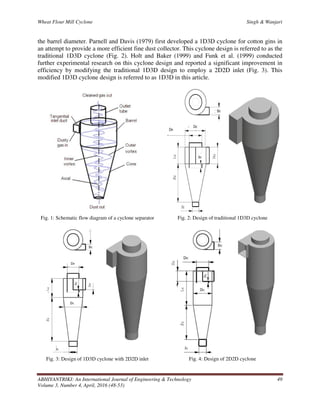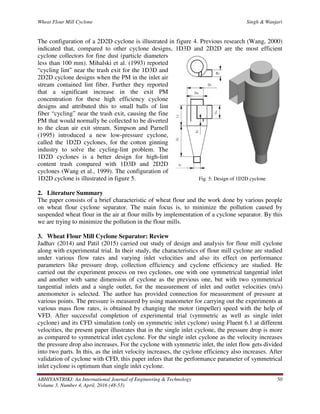This document is a literature review on cyclone separators used in wheat flour mills, detailing their design, operational efficiency, and the impact of various parameters on their performance. It highlights the importance of cyclone separators in minimizing dust pollution in flour mills and discusses various studies conducted on cyclone performance, design modifications, and empirical validations. The review concludes that symmetrical inlet cyclones perform better than single inlet designs and that cyclone efficiency increases with reduced body diameter and lower inlet velocity.




![Wheat Flour Mill Cyclone Singh & Wanjari
ABHIYANTRIKI: An International Journal of Engineering & Technology 52
Volume 3, Number 4, April, 2016 (48-53)
have discussed the research carried out by Whitby and Heywood. They have used fine sieving
mechanism and concluded that sieving can be divided into two different steps, one- having the
particle size much smaller than the sieve opening, while the other- is having the particle size
close to that of the sieve opening. The present paper gives more attention to Kent Jones et al.
technique, which describes the sedimentation procedure, followed by photo sedimentation
method, in which the percentage of different sized particle in flour is correlated with the decrease
in cloudiness with time. The paper provides the tabulated details of flour sample. Table 1 shows
the sedimentation in various solvents like Ethanol, Benzene, Isobutanol, Ethyl-Hexanol of flour
size; ranging from 5 to 120 microns. Table 2 (from 5 to 120 micron) and Table 3 (2 to 30
microns), illustrate the comparison values of different methods used. Using the tabulated values,
the graph is plotted between percentages of weight on Abscissa, while size of particle in microns
on ordinate. The plotted graph concludes that, the percentage weight is less than 10% or larger
than 90%, the control limits must be set for each technique independently. The various methods
which were calibrated, agree with one another as far as average size and the shape of the
distribution curve give results that are significantly different from one another, if only one point
in the distribution curve is considered. Therefore, one-point limits, which are agreeable to
describe size, should be set independently.
Sullivan et al. (1960) worked to investigate the relationship of particle size and endosperm
structure to ash, protein, maltose value, and gassing power as determined from air-classified
fractions of flour. The flour was air-classified in an Alpine 132-MP Mikroplex classifier nineteen
times. This paper aims, to resolve flour completely into fractions of variable particle size by
means of air-classification. Fig. 1 (on page 440), provides classification procedure and vane
setting (given in degree and the feed setting is in mm) of 19 classifier. The original flour (labeled
sample 1), was passed through the smooth rolls of an experimental Allis mill a total of five
times, in order to reduce the flour to a finer average granulation by roll pressure. The same flour
was also ground in an Alpine 160-Z pin mill, once at a speed of 17,500 rpm and labeled sample
2. Sample 1 and 2, were ground mainly for comparison of maltose, gassing power, and
amylograph data with original flour and they are further analyzed by conventional procedure
outlined in cereal laboratory method. The author provides the result in a tabulated form and after
mathematical analysis, states that:
• In a very low micron size (under 8 microns), the ash content is roughly, double that of the
parent flour.
• From 15 to 30 microns, the ash content increases, probably because the ratio of small
endosperm cells and peripheral cells to starch granules increases.
• From approximately 30 to 70 microns, the ash again decreases.
• From 70 to 100 microns and over, the ash in this particle size increases, as there is
increase in number of covered and partially covered cells.
4. Conclusion
From the study and analysis of different papers, it is observed that, the pressure drop and cyclone
efficiency varies with inlet velocity. The efficiency of cyclone increases with the decrease in
dimensions of cyclone body diameter, cyclone width, operating temperature and cyclone width
inlet [5]. The pressure drop increases with the increase in inlet velocity; but pressure drop
decreases significantly with the rise in temperature [1]. Comparison of performance, between](https://image.slidesharecdn.com/1605012-230319150755-be8c8282/85/Cyclone-Separator-5-320.jpg)
![Wheat Flour Mill Cyclone Singh & Wanjari
ABHIYANTRIKI: An International Journal of Engineering & Technology 53
Volume 3, Number 4, April, 2016 (48-53)
symmetrical inlet cyclone and single inlet cyclone shows that, symmetrical inlet cyclone is
optimum than the conventional cyclone with single inlet [2].
References
[1] Patil, R. (2015). Design and analysis for flour mill cyclone. IJLTEMAS. 6(6), pp. 11-14.
[2] Jadhav, MR. (2014). Design of cyclone and study of its performance parameters. IJMERR. 3(10),
pp. 247-252.
[3] Sonaye, SY, & Baxi, RN. (2012). Particle size measurement and analysis of Flour. IJERA. 3(3),
pp. 1839-1842.
[4] Gopani, N & Bhargava, A. (2011). Design of High Efficiency Cyclone for Tiny Cement Industry.
International Journal of Environmental Science and Development. 2(5).
[5] Khairy, E & Lacor, C. (2010). Numerical Study on the Effect of Cyclone Inlet Height on the
Flow Pattern and Performance. In: Proceedings of 10th
International Congress of Fluid Dynamics.
[6] Wang, L, Parnell, CB, Shaw, BW, & Lacey, RE. (2006). A theoretical approach for predicting
number of turns and cyclone pressure drop. ASABE. 49(2), pp.491-503.
[7] Thomas, JG, Choong, SY, Fakhru’l-razi, A, & Chuah, TG. (2004). Prediction of the Effect of
Dimension, Particle Density, Temperature, and Inlet Velocity on the Cyclone Collection
Efficiency. Chemical Engineering and Processing.
[8] Irani, RR, & Fong, WS. (1961). Measurement of the particle size distribution of flour. Chem. 38,
pp. 67-75.
[9] Sullivan, B, Engebretson, WE, & Anderson, ML. (1960). The relation of particle size to certain
flour characteristics. pp. 436-455.
Appendix
Nomenclature
D = Barrel diameter of Cyclone.
A = Cyclone inlet height (mm).
Dc = Barrel Diameter.
Lc = Length of Barrel.
Zc = Length of cone.
De = Dia. of outlet tube.
Hc = Height of inlet duct.
Bc = Width of inlet.
Jc = Outlet dia. of cone.](https://image.slidesharecdn.com/1605012-230319150755-be8c8282/85/Cyclone-Separator-6-320.jpg)